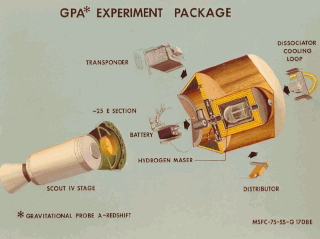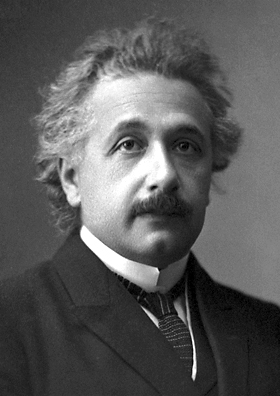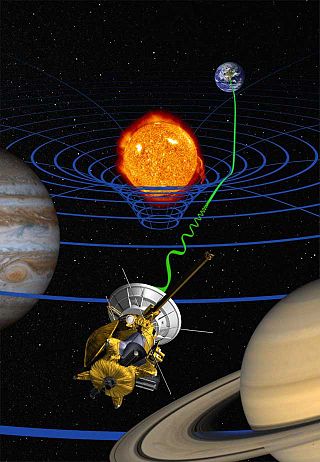Faster-than-light travel and communication are the conjectural propagation of matter or information faster than the speed of light in vacuum. The special theory of relativity implies that only particles with zero rest mass may travel at the speed of light, and that nothing may travel faster.

In physics, the special theory of relativity, or special relativity for short, is a scientific theory of the relationship between space and time. In Albert Einstein's 1905 paper, On the Electrodynamics of Moving Bodies, the theory is presented as being based on just two postulates:
- The laws of physics are invariant (identical) in all inertial frames of reference. This is known as the principle of relativity.
- The speed of light in vacuum is the same for all observers, regardless of the motion of light source or observer. This is known as the principle of light constancy, or the principle of light speed invariance.

The speed of light in vacuum, commonly denoted c, is a universal physical constant that is exactly equal to 299,792,458 metres per second. According to the special theory of relativity, c is the upper limit for the speed at which conventional matter or energy can travel through space.

The theory of relativity usually encompasses two interrelated physics theories by Albert Einstein: special relativity and general relativity, proposed and published in 1905 and 1915, respectively. Special relativity applies to all physical phenomena in the absence of gravity. General relativity explains the law of gravitation and its relation to the forces of nature. It applies to the cosmological and astrophysical realm, including astronomy.

In physics, the twin paradox is a thought experiment in special relativity involving twins, one of whom takes a space voyage at relativistic speeds and returns home to find that the twin who remained on Earth has aged more. This result appears puzzling because each twin sees the other twin as moving, and so, as a consequence of an incorrect and naive application of time dilation and the principle of relativity, each should paradoxically find the other to have aged less. However, this scenario can be resolved within the standard framework of special relativity: the travelling twin's trajectory involves two different inertial frames, one for the outbound journey and one for the inbound journey. Another way to understand the paradox is to realize the travelling twin is undergoing acceleration, which makes them a non-inertial observer. In both views there is no symmetry between the spacetime paths of the twins. Therefore, the twin paradox is not actually a paradox in the sense of a logical contradiction.
In physics, the principle of relativity is the requirement that the equations describing the laws of physics have the same form in all admissible frames of reference.
Causality is the relationship between causes and effects. While causality is also a topic studied from the perspectives of philosophy and physics, it is operationalized so that causes of an event must be in the past light cone of the event and ultimately reducible to fundamental interactions. Similarly, a cause cannot have an effect outside its future light cone.
Time dilation is the difference in elapsed time as measured by two clocks, either because of a relative velocity between them, or a difference in gravitational potential between their locations. When unspecified, "time dilation" usually refers to the effect due to velocity.

Length contraction is the phenomenon that a moving object's length is measured to be shorter than its proper length, which is the length as measured in the object's own rest frame. It is also known as Lorentz contraction or Lorentz–FitzGerald contraction and is usually only noticeable at a substantial fraction of the speed of light. Length contraction is only in the direction in which the body is travelling. For standard objects, this effect is negligible at everyday speeds, and can be ignored for all regular purposes, only becoming significant as the object approaches the speed of light relative to the observer.

Gravity Probe A (GP-A) was a space-based experiment to test the equivalence principle, a feature of Einstein's theory of relativity. It was performed jointly by the Smithsonian Astrophysical Observatory and the National Aeronautics and Space Administration. The experiment sent a hydrogen maser—a highly accurate frequency standard—into space to measure with high precision the rate at which time passes in a weaker gravitational field. Masses cause distortions in spacetime, which leads to the effects of length contraction and time dilation, both predicted results of Albert Einstein's theory of general relativity. Because of the bending of spacetime, an observer on Earth should measure a slower rate at which time passes than an observer that is higher in altitude. This effect is known as gravitational time dilation.
The chronology protection conjecture is a hypothesis first proposed by Stephen Hawking that laws of physics beyond those of standard general relativity prevent time travel—even when the latter theory states that it should be possible. The permissibility of time travel is represented mathematically by the existence of closed timelike curves in some solutions to the field equations of general relativity. The chronology protection conjecture should be distinguished from chronological censorship under which every closed timelike curve passes through an event horizon, which might prevent an observer from detecting the causal violation.

Modern physics is a branch of physics that developed in the early 20th century and onward or branches greatly influenced by early 20th century physics. Notable branches of modern physics include quantum mechanics, special relativity, and general relativity.
Gravitational time dilation is a form of time dilation, an actual difference of elapsed time between two events, as measured by observers situated at varying distances from a gravitating mass. The lower the gravitational potential, the slower time passes, speeding up as the gravitational potential increases. Albert Einstein originally predicted this in his theory of relativity, and it has since been confirmed by tests of general relativity.
Terrell rotation or the Terrell effect is the visual distortion that a passing object would appear to undergo, according to the special theory of relativity, if it were travelling at a significant fraction of the speed of light. This behaviour was described independently by both Roger Penrose and James Edward Terrell. Penrose's article was submitted 29 July 1958 and published in January 1959. Terrell's article was submitted 22 June 1959 and published 15 November 1959. The general phenomenon was noted already in 1924 by Austrian physicist Anton Lampa.

General relativity is a theory of gravitation developed by Albert Einstein between 1907 and 1915. The theory of general relativity says that the observed gravitational effect between masses results from their warping of spacetime.
COLLADA is an interchange file format for interactive 3D applications. It is managed by the nonprofit technology consortium, the Khronos Group, and has been adopted by ISO as a publicly available specification, ISO/PAS 17506.

The Sagnac effect, also called Sagnac interference, named after French physicist Georges Sagnac, is a phenomenon encountered in interferometry that is elicited by rotation. The Sagnac effect manifests itself in a setup called a ring interferometer or Sagnac interferometer. A beam of light is split and the two beams are made to follow the same path but in opposite directions. On return to the point of entry the two light beams are allowed to exit the ring and undergo interference. The relative phases of the two exiting beams, and thus the position of the interference fringes, are shifted according to the angular velocity of the apparatus. In other words, when the interferometer is at rest with respect to a nonrotating frame, the light takes the same amount of time to traverse the ring in either direction. However, when the interferometer system is spun, one beam of light has a longer path to travel than the other in order to complete one circuit of the mechanical frame, and so takes longer, resulting in a phase difference between the two beams. Georges Sagnac set up this experiment in 1913 in an attempt to prove the existence of the aether that Einstein's theory of special relativity makes superfluous.
In classical theories of gravitation, the changes in a gravitational field propagate. A change in the distribution of energy and momentum of matter results in subsequent alteration, at a distance, of the gravitational field which it produces. In the relativistic sense, the "speed of gravity" refers to the speed of a gravitational wave, which, as predicted by general relativity and confirmed by observation of the GW170817 neutron star merger, is equal to the speed of light (c).

Away3D is an open-source platform for developing interactive 3D graphics for video games and applications, in Adobe Flash or HTML5. The platform consists of a 3D world editor, a 3D graphics engine, a 3D physics engine and a compressed 3D model file format (AWD).










